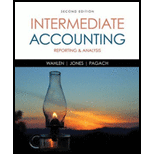
Ascertain the following ratios of Company B:
- 1. Earnings per share.
- 2. Gross profit margin.
- 3. Operating profit margin.
- 4. Net profit margin.
- 5. Total assets turnover ratio.
- 6. Return on assets ratio.
- 7. Return on common equity.
- 8. Receivables turnover ratio.
- 9. Interest coverage.
Explanation of Solution
Earnings per share (EPS): The amount of net income available to each shareholder per common share outstanding is referred to as earnings per share (EPS).
Gross margin (gross profit): Gross margin is the amount of revenue earned from goods sold over the costs incurred for the goods sold.
Net margin: This ratio gauges the operating profitability by quantifying the amount of income earned from business operations from the sales generated.
Asset turnover ratio:
The Asset turnover is a contrast to the profit margin ratio and it is calculated to determine the net sales and average total assets. Use the following formula to calculate the asset turnover ratio:
Return on assets:
Return on assets is the ratio of the net income, and interest expense to the average total assets. The
Accounts receivable turnover is a liquidity measure of accounts receivable in times, which is calculated by dividing the net credit sales by the average amount of net accounts receivables. In simple, it indicates the number of times the average amount of net accounts receivables has been collected during a particular period.
Average collection period:
Average collection period indicates the number of days taken by a business to collect its outstanding amount of accounts receivable on an average. It is otherwise known as days to collect.
Compute the ratio as follows:
- 1. Calculate the earnings per share of Company B:
- 2. Calculate the gross profit margin of company B:
- 3. Calculate the operating profit margin of company B:
- 4. Calculate the net profit margin of company B:
- 5. Calculate the total asset turnover ratio of Company B:
Working note (1):
Calculate the value of average total assets.
- 6. Calculate the return on total assets of Company B:
Working note (2):
Calculate the value of interest expense.
- 7. Calculate the return on common equity of Company B:
Working note (3):
Calculate the average shareholder’s equity.
- 8. Calculate the receivable turnover of Company B:
Working note (4):
Compute the net credit sales:
Working note (5):
Compute the average net receivable:
- 9. Calculate the interest coverage of Company B:
Want to see more full solutions like this?
Chapter 5 Solutions
Intermediate Accounting: Reporting and Analysis
- I am looking for a reliable way to solve this financial accounting problem using accurate principles.arrow_forwardPlease show me how to solve this financial accounting problem using valid calculation techniques.arrow_forwardCould you help me solve this financial accounting question using appropriate calculation techniques?arrow_forward
- How can I solve this financial accounting problem using the appropriate financial process?arrow_forwardhow much overhead cost would be assigned to product G98X using the activity based costing system ?arrow_forwardThe closing price of a stock is $74.55, and the net earnings per share are $3.50. The stock's P/E ratio is .arrow_forward
 Financial AccountingAccountingISBN:9781305088436Author:Carl Warren, Jim Reeve, Jonathan DuchacPublisher:Cengage Learning
Financial AccountingAccountingISBN:9781305088436Author:Carl Warren, Jim Reeve, Jonathan DuchacPublisher:Cengage Learning Managerial Accounting: The Cornerstone of Busines...AccountingISBN:9781337115773Author:Maryanne M. Mowen, Don R. Hansen, Dan L. HeitgerPublisher:Cengage Learning
Managerial Accounting: The Cornerstone of Busines...AccountingISBN:9781337115773Author:Maryanne M. Mowen, Don R. Hansen, Dan L. HeitgerPublisher:Cengage Learning Financial Accounting: The Impact on Decision Make...AccountingISBN:9781305654174Author:Gary A. Porter, Curtis L. NortonPublisher:Cengage Learning
Financial Accounting: The Impact on Decision Make...AccountingISBN:9781305654174Author:Gary A. Porter, Curtis L. NortonPublisher:Cengage Learning Cornerstones of Financial AccountingAccountingISBN:9781337690881Author:Jay Rich, Jeff JonesPublisher:Cengage Learning
Cornerstones of Financial AccountingAccountingISBN:9781337690881Author:Jay Rich, Jeff JonesPublisher:Cengage Learning Managerial AccountingAccountingISBN:9781337912020Author:Carl Warren, Ph.d. Cma William B. TaylerPublisher:South-Western College Pub
Managerial AccountingAccountingISBN:9781337912020Author:Carl Warren, Ph.d. Cma William B. TaylerPublisher:South-Western College Pub Financial And Managerial AccountingAccountingISBN:9781337902663Author:WARREN, Carl S.Publisher:Cengage Learning,
Financial And Managerial AccountingAccountingISBN:9781337902663Author:WARREN, Carl S.Publisher:Cengage Learning,





